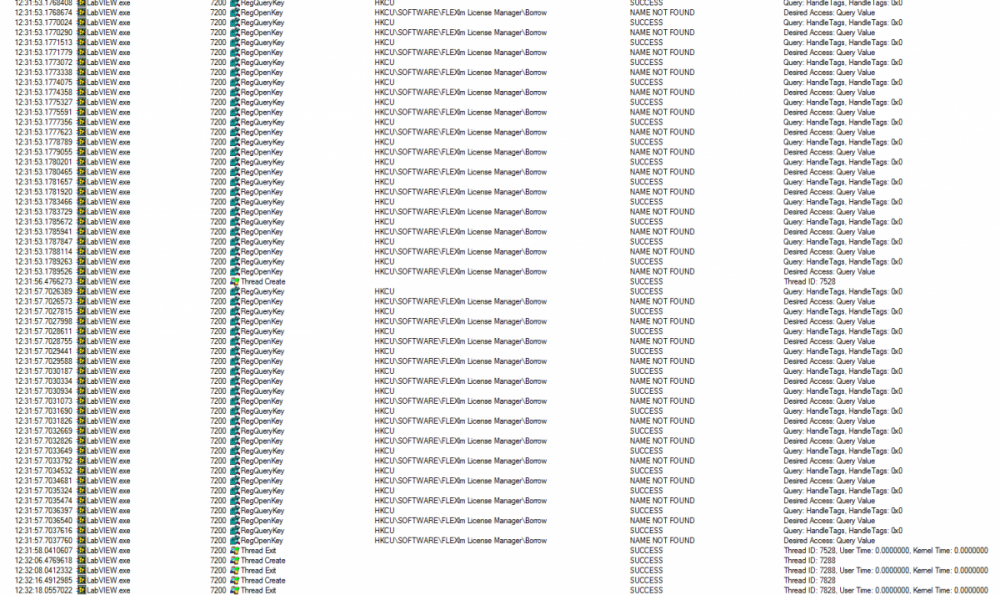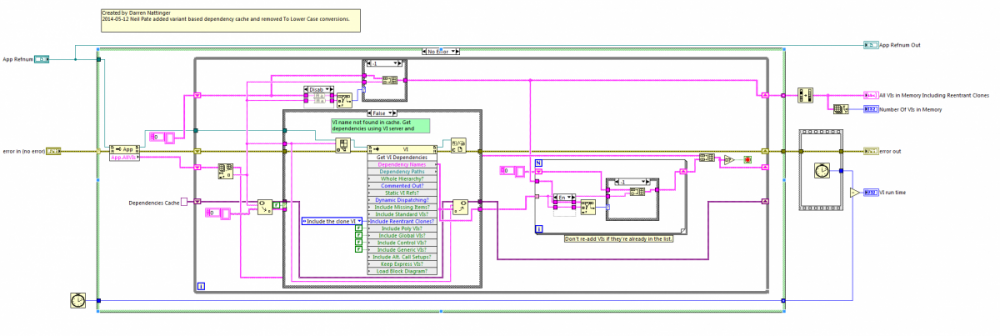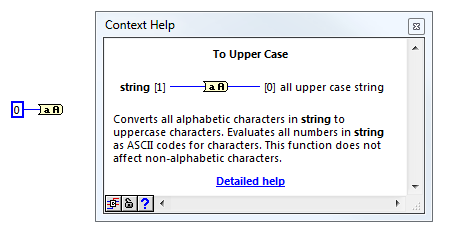-
Posts
1,192 -
Joined
-
Last visited
-
Days Won
110
Content Type
Profiles
Forums
Downloads
Gallery
Everything posted by Neil Pate
-
Hi all, If I get time I would like to refactor "Get All VIs in Memory.." that and its parent VI to remove a lot of the duplicate operations and array manipulations. For now though an easy performance boost is to cache the VI Dependencies. I have used variant attributes as a quick and dirty cache, as shown. I get approx 50% speedup for large projects (> 2500 VIs). With a bit of thought I am sure it can also be applied to the other temporary arrays that are used in this VI. Comments? The VI attached is saved in 2013. Get All VIs in Memory Including statically-referenced Reentrant Clones.vi
-
Today I learned you can pass an I32 into the To Upper Case prim. Did this totally by accident. Has anybody ever used this feature before?
-

Should an application have File >> Exit?
Neil Pate replied to Aristos Queue's topic in LabVIEW General
I always put File-->Exit on every application that has a menu-bar, however my personal preference (as others have also said) these days is to handle the Panel close event so I put in both. To me the only no-no is a big fat Exit button on the GUI. -
Have you tried running the executable on your PC but with the source directory renamed to something else? This can help diagnose if some VIs/classes etc are not being included in the exe but are on your disk so the built application works fine. Also try move the exe somewhere else (on your PC) as if the application has relative paths to source code VIs it should then fail.
-

Interested in your ideas for improving the JKI State Machine
Neil Pate replied to Jim Kring's topic in LabVIEW General
OK point taken. I think my uses of the JKI template are much more localised (maybe the word I am looking for is specialised, but even this does not really convey what I mean, perhaps what I just mean is "simple") so my private data in the shift register is a bit more cohesive. I do not have a cluster-saurus with myriad elements. -

Interested in your ideas for improving the JKI State Machine
Neil Pate replied to Jim Kring's topic in LabVIEW General
So what do you do when you need to execute a reasonably complicated bit of code which requires various bits of "data" in this cluster (i.e. a portion of code that screams out to be made into a sub-VI, which in my opinion is virtually anything non-trivial)? Do you unbundle the specific elements and pass them into a sub VI? I know it may be frowned upon, but by having the cluster typedef'd I then just pass the whole thing into/out of a sub-VI. Of course you could pass in a non-typedef cluster but we know how that is going to end... -

Interested in your ideas for improving the JKI State Machine
Neil Pate replied to Jim Kring's topic in LabVIEW General
It would be nice if the template could include a typedef for the main cluster on the shift register, I normally end up creating one. -
Just to chip in here, I recently had the same problem (2013 SP1). Bundling in a "variable" wire did not cause the class output "cluster" to be updated. Bundling in a constant (in this instance it was a string) did cause the "cluster" to be updated correctly. Probably entirely related, editing some code in this class would cause the IDE to hard-crash, so I figure I just managed to get my code in a state that was not consistent. I fixed my problem by deleting the VI that caused the crash and re-creating it from scratch. I think the inconsistency happened when I renamed a class VI to something that had previously existed in that class.
-
In LabVIEW (and perhaps all Web Services, I am not sure here) the connection string is in the form: host_address:port/WebServiceName/QueryString so it just seems to me that something is redundant here. You can infact have multiple Web Services on the same port when running in the IDE, but then I suppose there is only a single application (LabVIEW.exe) that is bound to the port. However as soon as you have built applications this paradigm breaks.
-

Adapt to Type: Handles by Value vs. Pointers to Handles
Neil Pate replied to GeorgeG's topic in Calling External Code
Something to add (note, this is just something I "figured" out, it is completely uneducated and could be totally wrong) on the handle vs a pointer to a handle... Dealing with a pointer to a handle is a mechanism that allows the underlying memory allocation mechanism to do stuff like defrag or completely change your memory allocation without affecting your running application. Your application has a constant "memory address" that is the pointer to the handle. Then any actual requests to memory always go through the lower level manager (i.e. LabVIEW's memory manager) which actually does the translation between the handle that your app knows about, and the actual physical memory address. No doubt I am using all the wrong vocabulary here, picture me waving my hands in the air to get an idea that I only have a vague notion that I know what I am talking about. -
I was being a bit facetious, but I did not know about it only being TLS, so I forgive you. I have a ten week old at home, I didn't get to sleep with anybody last night
-
Just tried out something that I would have expected should work, but doesn't. As a Web Service is identified by a name I would have expected I could run several of them on the same system with the same port. This does not work, whichever service is started first works, the other does not. Moving the second Web Service to a different port works properly. Am I being unreasonable with my expectations here? I know enough about ports to be dangerous but that is about all, is there some underlying restriction of the OS (Windows in this instance) that only allows one application to bind onto a port? The reason I am doing this is to try and create a test environment so that I do not affect my production Web Service application.
-
It's a good thing NI never got around to making an SSH toolkit
-
So, most of you here are probably aware of the Heartbleed bug in OpenSSL. How seriously is everybody taking this? Seems like a good time to change my password; "12345" was probably due for an extra digit on the end by now ;-)
-

Hand-RIO Self hardware can use LabVIEW FPGA and RT Module to Program
Neil Pate replied to wuxingsoho's topic in Hardware
Neat! It sure beats the stuff I did in university... -
I recently took a peek at some C++ I did in post-grad. Ouch! "Clever" variable names, swearing in comments, massive functions... The things you do when you are young
-
Thanks guys. The code in question was written by myself some time ago (circa 2007). I was creating a NaN by dividing by zero, I suppose at the time I did not even bother to consider the "correctness" of the conversion, it worked and I just accepted it and moved on to the next thing. I find it really educational to look back at my old code and see how my style has changed. Coercion dots all over the place, no defensive programming techniques etc etc.
-
Hi All, I am in the process of porting a LV8.5 application to LV2013. One thing I have noticed is that there is a difference in behaviour when converting a NaN (DBL) to U32 using the To Unsigned Long Integer primitive. In LV8.5 NaN is converted to 0 In LV2013 NaN is converted to 4294967295 (the maximum a U32 can hold). Does anybody known when this changed, and does this seem like a reasonable change? This could lead to some very strange bugs!
-
Version 1.0
5,096 downloads
This project is a 100% G based Rubiks Cube solver that I coded quite a while ago (2007) and then forgot about. I must have saved it it more recently in LV2011. The algorithm is based on the 7-step method, which is totally sub-optimal for solving a cube, but relatively simple to understand. Please note this code is not representative of my current coding ability, I just upload it in case anybody is interested. If I get time I would like to do a 3D representation of the cube and allow the manipulations to be done in this view. Run instructions: set the show boolean to True click randomise! pick a start colour click solve! The buttons on the left hand side can be used to do manual manipulations of the cube.






